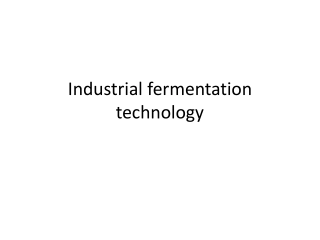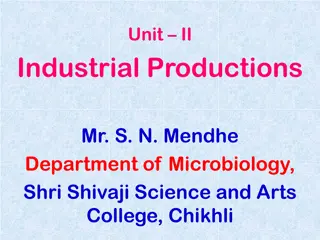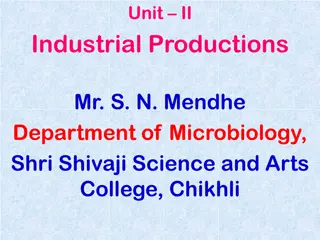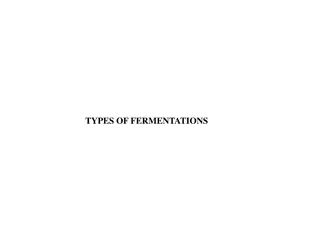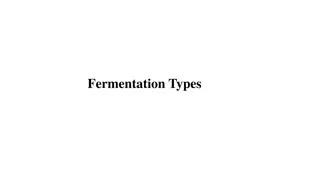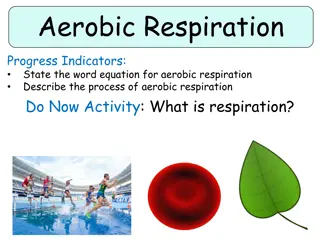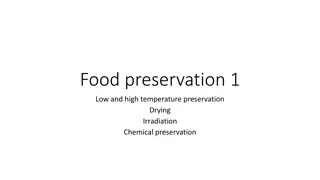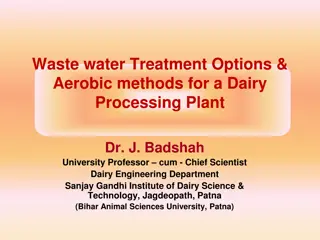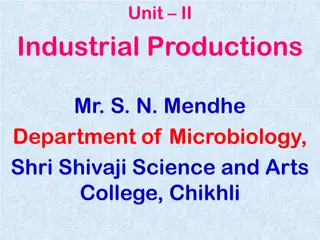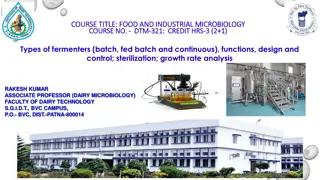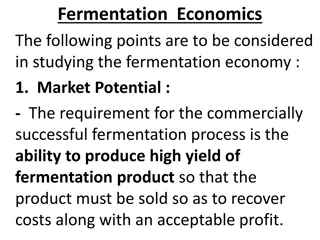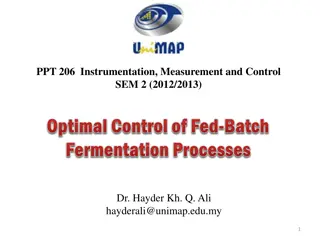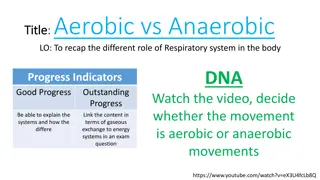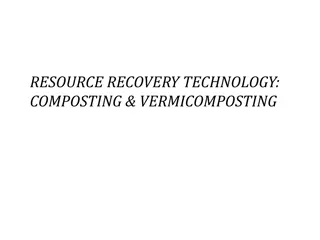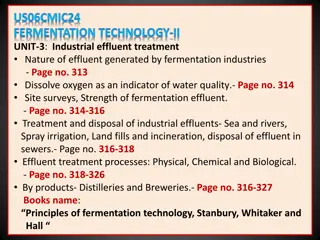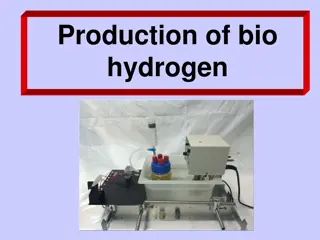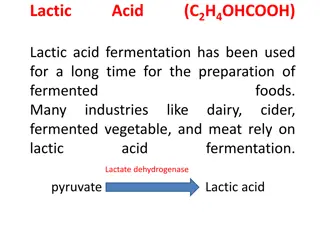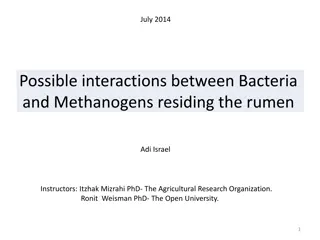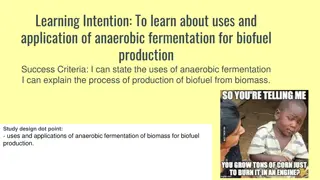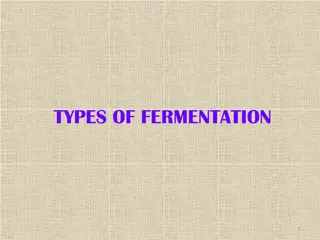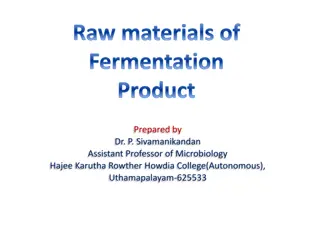Respiration
The definition and role of aerobic respiration, the overall sequence of reactions for glucose, and the two-stage process. Explore the concepts of anaerobic respiration and fermentation, including the role of microorganisms in industrial fermentation. Discover the cellular location of each stage and
0 views • 11 slides
Industrial fermentation technology
Industrial fermentation technology involves three key stages - Up-Stream Processing (USP), the fermentation process, and Down-Stream Processing (DSP). USP includes formulating the fermentation medium, sterilization, inoculum preparation, and improving desired microorganisms for increased productivit
1 views • 23 slides
Precision Fermentation in Sustainable Food Production
Precision Fermentation is a specialized bioprocessing technique that utilizes microbes as cell factories to produce specific functional ingredients like proteins, vitamins, enzymes, and more. This innovative technology addresses the challenges of increasing food demands in a sustainable way, offerin
1 views • 12 slides
Our Beautiful Stinky Friends
Delve into the fascinating world of fermentation with chef/scientist David Zilber in this insightful listening guide based on the Science Friday podcast. Explore the science, ingredients, and techniques behind fermentation as Zilber shares his expertise and tips for home fermenters. Enhance your kno
0 views • 9 slides
Industrial Production of Ethyl Alcohol: Processes and Microorganisms
Ethyl alcohol production from molasses involves specific steps like selecting yeast strains, preparing inoculum, and creating fermentation conditions. Yeasts like Saccharomyces cerevisiae play a crucial role due to their alcohol tolerance and rapid growth properties. The process requires careful han
1 views • 23 slides
Industrial Production of Citric Acid and Microbial Fermentation
Industrial production of citric acid has evolved from extraction processes to microbial fermentation, offering various industrial applications. Citric acid is utilized as an acidulant in food and pharmaceutical industries, a chelating agent in tanning, and a flavor enhancer in carbonated beverages.
1 views • 18 slides
Understanding Different Types of Fermentations
Alcoholic fermentation involves the production of ethanol, commonly carried out by yeasts like Saccharomyces cerevisiae. On the other hand, lactic acid fermentation results in the production of lactic acid through two types: homo-fermentative and heterofermentative pathways. Different substrates and
2 views • 23 slides
Understanding Types and Benefits of Solid State Fermentation
Fermentation is a metabolic process involving enzymes transforming organic substrates. Solid state fermentation (SSF) is a method without free water, crucial for enzyme production using natural materials like grains and fruit pulps. This process is cost-effective, environmentally friendly, and easy
1 views • 15 slides
Understanding Aerobic Respiration and Cell Structures
Explore the process of aerobic respiration, why we need oxygen for energy production, and the importance of cell structures in this metabolic pathway. Discover the role of key organelles like mitochondria and the cell membrane, as well as the differences between animal and plant cells in respiration
0 views • 10 slides
Understanding Bioprocess Technology and its Applications
Bioprocess technology involves utilizing living cells or their components like bacteria and enzymes to produce desired products through fermentation. This field covers a range of processes, including microbial bioprocesses, enzyme production, metabolite synthesis, recombinant products, and transform
0 views • 15 slides
Understanding Fermentation as a Food Preservation Technique
Fermentation is a natural process where microorganisms alter the sensory and functional properties of food to create a desirable end product. This method not only extends shelf life but also improves nutritional value, aids digestibility, and enhances food safety. Fermentation does not require expen
1 views • 31 slides
Waste Water Treatment Options for Dairy Processing Plants
Factors influencing waste water treatment options for a dairy processing plant include volume and flow rates, chemical characteristics, biodegradability, controlling levels of suspended solids, BOD, and COD in discharged water. Dairy wastes have high BOD due to lactose, fats, proteins, nitrogen, and
0 views • 17 slides
Industrial Production of Citric Acid: Fermentation Processes and Applications
Citric acid is industrially produced through microbial fermentation processes. It is widely used in various industries such as food, pharmaceuticals, and beverage production. Different methods like surface culture fermentation are employed for citric acid manufacture, with fungi like Aspergillus nig
4 views • 18 slides
Understanding the Industrial Production of Vinegar
Vinegar fermentation, with its rich history and diverse classification based on raw materials, involves two essential fermentations - alcoholic fermentation and acetous fermentation. Various microorganisms, particularly Acetobacter species, play a crucial role in vinegar production. Different method
0 views • 15 slides
Industrial Production of Wines: Process and Classes
Wine production involves fermentation of grapes with variations in color, alcohol, and sugar content, resulting in different classes of wines like red, white, sweet, dry, sparkling. The process includes grape selection, fermentation, aging, and bottling to create high-quality wines.
3 views • 16 slides
Understanding Triple Sugar Iron Agar (TSI Agar) Test
Triple Sugar Iron Agar (TSI Agar) is a differential media used for identifying gram-negative enteric bacilli based on carbohydrate fermentation and hydrogen sulfide production. It helps detect carbohydrate fermentation, gas production, acidification, and H2S formation, providing valuable information
1 views • 28 slides
Understanding Fermentation and Bioreactors in Food and Industrial Microbiology
Fermentation is a crucial process where substances break down into simpler forms using organisms, generating energy. Bioreactors are systems supporting biochemically active environments for specific organisms, either aerobic or anaerobic. Learn about the history, importance, and applications of ferm
1 views • 16 slides
Understanding Fermenter Design and Functionality
The fermenter is essential in the fermentation process, providing a controlled environment for biomass and product yields. It enables aseptic fermentation, optimal mixing, and aeration without excessive power consumption. Key functions include temperature control, pH regulation, and minimizing evapo
1 views • 36 slides
Understanding Fermentation Economics: Key Market Considerations
Studying the fermentation economy involves assessing market potential, competition, cost recovery, and distribution strategies. Market demand, competition, production costs, and potential profits are crucial factors to consider for successful commercial fermentation processes. Foreign sales can offe
0 views • 19 slides
Principles of Fed-Batch Fermentation in Biotechnology
Explore the concept of fed-batch fermentation, a key technique in biotechnological processes. This method involves adding nutrients in controlled doses based on specific criteria to optimize cell growth and minimize undesirable metabolic pathways. Fed-batch systems allow for high cell densities and
0 views • 24 slides
Principles and Frameworks for Exercise Prescription Certificate Course Session 2
This session delves into the principles and frameworks for exercise prescription, focusing on topics such as prescribing aerobic exercise, the FITT principle, global recommendations for physical activity, and practical aerobic exercise examples. It also covers the benefits of regular physical activi
0 views • 48 slides
Understanding Aerobic and Anaerobic Exercise Systems
The content discusses the differences between aerobic and anaerobic exercise, detailing how each system utilizes oxygen or stored energy for energy production. It explores the role of gaseous exchange in energy systems and relates it to the respiratory system's function. Additionally, it covers the
0 views • 9 slides
Understanding Composting and Vermicomposting Technology
Composting and vermicomposting are controlled decomposition processes of organic materials, with aerobic microbes breaking down the matter in the presence of oxygen. Aerobic composting produces stable humus and helps eliminate pathogens and weed seeds. The processes involve microbial respiration, ga
1 views • 29 slides
Unveiling the Secrets of Mead: History, Making Process, and Fermentation
Delve into the world of mead, the ancient nectar of the gods, as we uncover its rich history dating back to the Paleolithic Period. Learn about the simple ingredients used in mead making, the role of yeast in fermentation, and the preservation benefits of this divine beverage. Explore the wisdom beh
9 views • 24 slides
Industrial Effluent Treatment in Fermentation Industries
Fermentation industries generate various types of effluent containing organic matter, solids, and other waste materials. With stricter regulations on waste disposal, efficient treatment methods are essential for controlled disposal. This includes physical, chemical, and biological processes to treat
0 views • 84 slides
Bio Hydrogen Production Experiment: Materials, Set-Up, and Procedure
This experiment focuses on the production of bio hydrogen using sugar beet cuttings and dried cultures as substrates. The materials required include a bioreactor, fuel cell, and various components for setting up the experiment. The experimental set-up involves preparing the fermentation bottle, subs
0 views • 18 slides
Understanding Yeast Dough: Types and Techniques
Yeast dough is the foundation of various baked goods, offering a canvas for creativity with different types such as lean, soft, and enriched dough. Learn about the basic ingredients, methods like straight dough mixing, and essential concepts like yeast hydration and bulk fermentation in baking. Disc
0 views • 6 slides
The Fascinating World of Food Fermentation
Explore the rich history and benefits of fermentation, from the early nomads' discovery of cheese and yogurt to Louis Pasteur's groundbreaking work. Learn about the different types of respiration, microbial fermentation in food production, and the energy-releasing process of cell respiration. Discov
0 views • 13 slides
Lactic Acid Fermentation in Food Industry
Lactic acid fermentation is a widely used method for producing fermented foods like dairy, vegetables, and meats. This process involves lactic acid bacteria and filamentous fungi to convert sugars into lactic acid. Various microbial cultures are utilized, and raw materials such as whey, molasses, an
0 views • 23 slides
Interactions Between Bacteria and Methanogens in the Rumen
The rumen, an anaerobic fermentation chamber in ruminant animals, houses a diverse microbial community including bacteria, fungi, protozoa, methanogenic archaea, and phages. Methanogens play a crucial role in methane production using fermentation end products. Research aims to explore evidence of in
0 views • 21 slides
Applications and Industrial Production of Fermentation in Various Sectors
Fermentation plays a crucial role in the production of organic solvents, food products, condiments, dairy products, processed meats, beverages, vitamins, and pharmaceutical compounds like antibiotics and vaccines. Specific examples include the production of citric acid, lactic acid, monosodium gluta
0 views • 6 slides
Understanding Yeast: The Living Organism and Its Respiration Processes
Explore the world of Saccharomyces cerevisiae (yeast) as a single-celled fungus that exists on all living matter. Learn about its genetic similarities to humans, its basic survival needs, and the processes of aerobic and anaerobic respiration, including fermentation. Discover how yeast, like us, rel
0 views • 26 slides
Comprehensive Physical Fitness and Training Guide by Eoin Bradley
Explore the realm of physical fitness through Aerobic Endurance, Skills, Strength, Speed, Power, Flexibility, Mobility, and Agility. Unveil the importance of Mobility, Flexibility, Strength, Aerobic Endurance, and more. Delve into specific training requirements for GAA Football and seasonal training
0 views • 23 slides
Understanding Rate Expressions in Heterogeneous Systems
In heterogeneous systems, the rate expression involves mass transfer terms alongside chemical kinetics terms due to the presence of multiple phases. Different types of heterogeneous systems have varying mass transfer complexities, making a general rate expression challenging to define. Examples such
0 views • 29 slides
Understanding Cellular Respiration and Fermentation Processes
Cellular respiration is the energy-releasing process in which organisms take in glucose and oxygen to produce carbon dioxide, water, and energy. This process is vital for all living organisms. Photosynthesis and respiration are opposite processes, with respiration requiring the products of photosynt
0 views • 10 slides
Anaerobic Fermentation for Biofuel Production: Uses and Applications
Anaerobic fermentation is a key process converting biomass into biogas without oxygen. Biofuels, such as bioethanol and biodiesel, derived from biomass like agricultural and industrial waste, offer renewable and environmentally friendly energy alternatives. The applications of anaerobic fermentation
0 views • 11 slides
Overview of Different Types of Fermentation Processes
Explore the various types of fermentation processes including batch fermentation, fed-batch fermentation, continuous fermentation, solid-state fermentation, anaerobic fermentation, and aerobic fermentation. Each process has its own advantages and disadvantages, influencing factors such as sterilizat
0 views • 18 slides
Effect of Six Weeks Morning or Evening Aerobic Exercise on Appetite and Anthropometric Indices
This study by Dr. Zahra Alizadeh explores the impact of six weeks of morning or evening aerobic exercise on appetite and anthropometric indices in overweight females. The research aims to understand how exercise timing affects these factors in sedentary overweight women aged 20-45, excluding those w
0 views • 37 slides
Raw Materials in Industrial Fermentation Processes
Microorganisms utilized in industrial fermentation require essential raw materials such as water, energy sources, carbon, nitrogen, mineral elements, and sometimes vitamins and oxygen. Various raw materials like cane molasses, beet molasses, cereal grains, starch, glucose, and lactose serve as carbo
0 views • 15 slides
Aerobic Gymnastics Competition Guidelines and Rules
The guidelines for aerobic gymnastics competitions include compulsory elements, categories, competition spaces, deductions, and specific rules for different age groups. The competitions have specific parameters for elements allowed, lifting, floor elements, music length, maximum difficulty elements,
0 views • 17 slides

